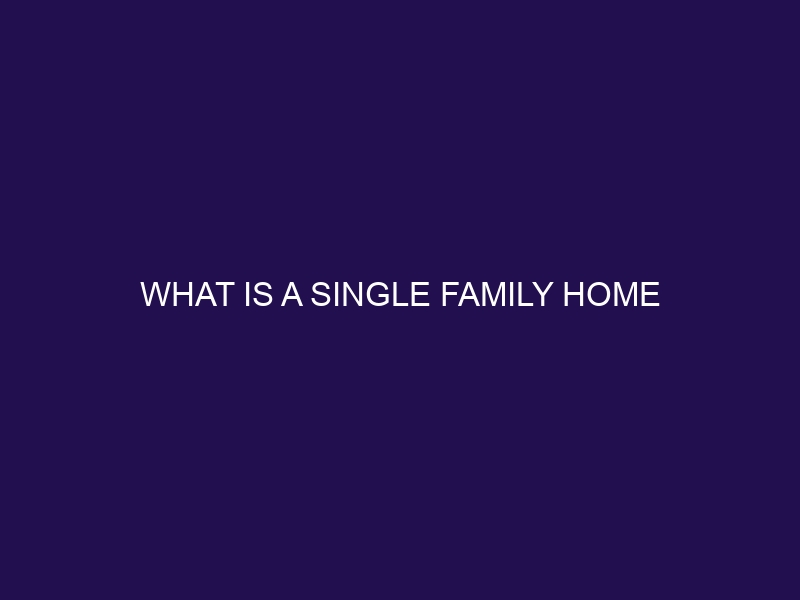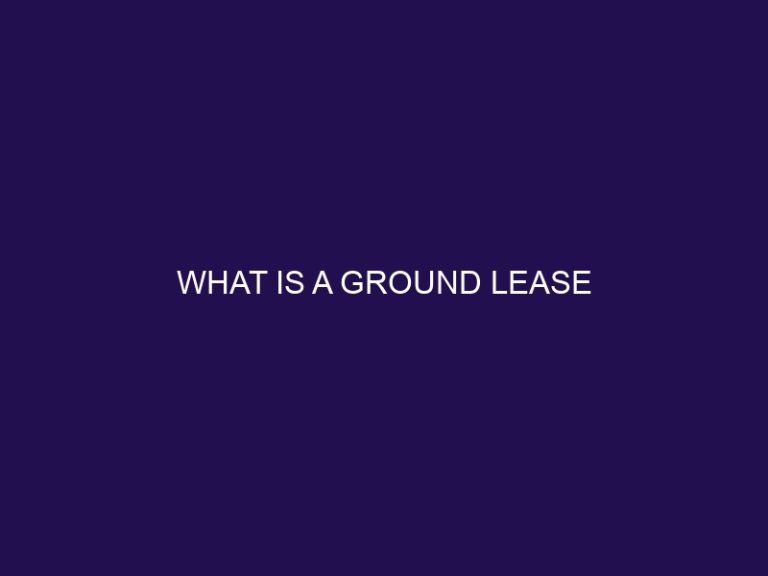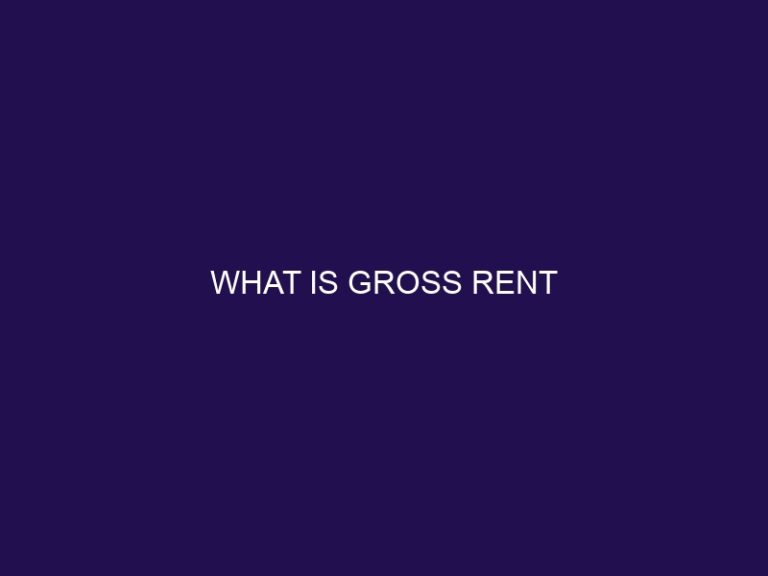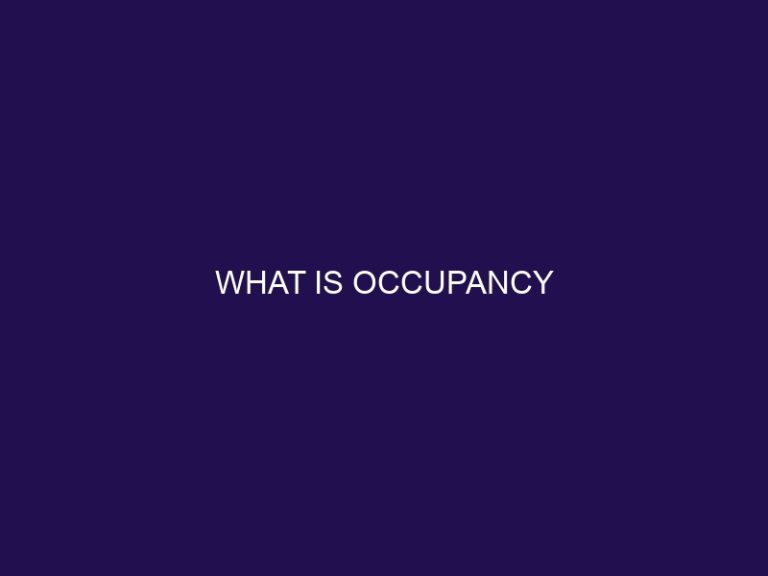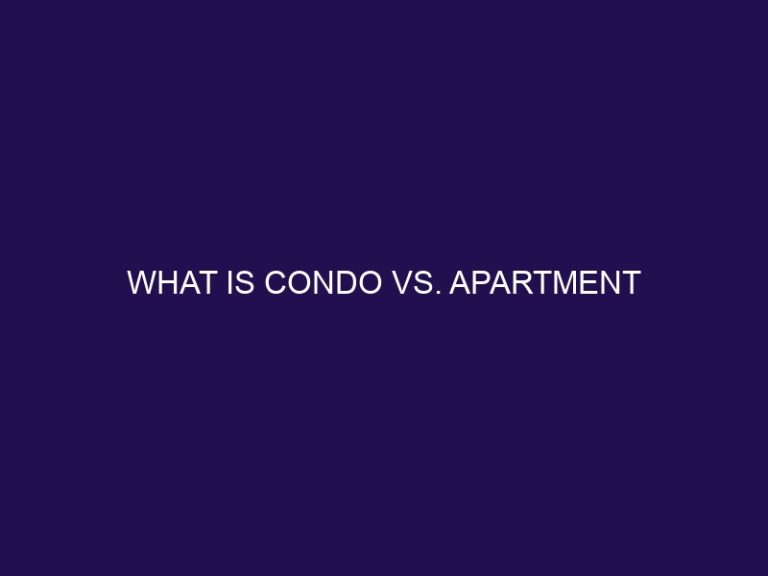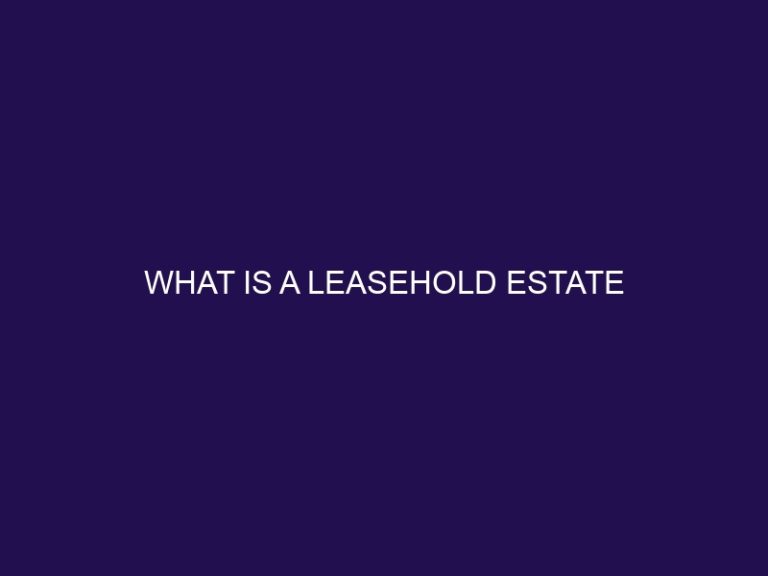What is a Single Family Home
A single family home is a type of residential property that is designed and built to accommodate one family. It is defined by certain characteristics that distinguish it from other types of housing. These characteristics include ownership, structure, and occupancy.
Ownership: A single family home is typically owned by a single individual or a family unit, as opposed to multiple owners or tenants.
Structure: Single family homes are standalone structures that are not connected to other dwellings. They are designed to be occupied by a single family and feature separate entrances and facilities.
Occupancy: A single family home is intended to be occupied by a single family unit for their exclusive use and enjoyment. It offers privacy and independence compared to multi-family or communal housing options.
Single family homes offer numerous advantages for homeowners. These advantages include:
- Privacy: Living in a single family home provides residents with a greater level of privacy compared to living in multi-family housing units.
- Outdoor Space: Single family homes often come with a yard or garden space, allowing residents to enjoy outdoor activities and have their own private green space.
- Customization: Homeowners have the freedom to personalize and customize their single family homes according to their preferences and needs.
- Investment: Single family homes can be a valuable long-term investment, as they often appreciate in value over time.
However, single family homes also have some disadvantages to consider. These disadvantages include:
- Cost: Single family homes tend to be more expensive compared to other types of housing, primarily due to the higher cost of land and construction.
- Maintenance: Homeowners are responsible for the maintenance and upkeep of their single family homes, which can require time, effort, and additional expenses.
- Responsibility: Owning a single family home means taking on additional responsibilities, such as property taxes, insurance, and repairs.
There are different types of single family homes, each with its own architectural style and characteristics. Some common types include Ranch, Cape Cod, Colonial, and Victorian homes, each offering a unique aesthetic and design.
Understanding what defines a single family home, its advantages and disadvantages, and the different types available can help potential homeowners make informed decisions about their housing choices.
What Defines a Single Family Home?
Discover the essence of a single family home – an abode that embodies warmth, coziness, and privacy. Unraveling the factors that define such a dwelling, we’ll delve into three key elements that make it truly unique. Ownership gives homeowners a sense of security and investment, while the structure provides a solid foundation for comfort and functionality. Occupancy reflects the intimate nature of a single family home, where personal connections thrive. Join us on this exploration of what makes a single family home the epitome of domestic bliss.
Ownership:
Ownership of a single family home entails the legal rights and duties associated with possessing the property. As the exclusive owner, you possess the liberty to make choices regarding the domicile, such as renovations and landscaping. Additionally, you hold the entitlement to vend or transfer the property. Ownership also carries financial obligations, including mortgage payments, property taxes, and homeowners insurance. It is crucial to carefully evaluate your financial situation and long-term objectives before undertaking the responsibility of owning a single family home. Pro-tip: Seek guidance from a real estate expert to fully comprehend the legal and financial ramifications of homeownership.
Structure:
The structure of a single-family home is an integral aspect of its design and functionality. The structure determines the layout, organization, and overall aesthetic appeal of the property. It comprises the foundation, walls, roof, and interior spaces, all of which play a vital role in providing stability, durability, and protection against natural elements. The foundation ensures the home’s stability, while the walls and roof provide structural support and shelter. Additionally, the interior spaces are carefully designed to maximize functionality and accommodate the needs of the occupants. In summary, the structure of a single-family home is crucial in creating a safe and comfortable living environment.
Here is a table showcasing the different components of a single-family home structure:
| Foundation | Provides stability and supports the weight of the home |
| Walls | Form the framework of the home and offer protection and privacy |
| Roof | Covers and protects the home from weather conditions |
| Interior Spaces | Includes rooms, walls, and partitions that define the living areas |
The concept of single-family homes dates back to ancient times when humans began to settle in permanent structures. Throughout history, different architectural styles and construction methods have been used to create unique and functional homes. From the humble cottages of medieval Europe to the grand Victorian houses of the 19th century, the structure of single-family homes has evolved to reflect cultural, societal, and technological advancements. Today, single-family homes continue to be a popular choice for individuals and families seeking privacy, space, and the freedom to customize their living environment.
Occupancy:
The term occupancy in relation to a single-family home refers to the number of individuals who permanently reside in the house. These types of homes are typically designed for the occupation of just one family or couple. As a result, only a single household lives in the home, ensuring both privacy and exclusivity. The advantage of having a single-family occupancy is that individuals can experience a sense of ownership without having to share common spaces or facilities with other tenants. Moreover, it grants the sole occupants greater control and responsibility over the property, allowing them to make decisions regarding maintenance and customization. When searching for a private and personalized living experience, it is worth considering the occupancy of a single-family home.
Advantages of Single Family Homes
Discover the many advantages of single family homes in this section! From unmatched privacy to ample outdoor space, the benefits are endless. Dive in to explore how these homes provide the perfect canvas for customization and can even be a smart investment. With a single family home, you can create your own little sanctuary, enjoy the great outdoors, make it uniquely yours, and watch its value grow. Get ready to learn why single family homes are truly in a league of their own!
Privacy:
Privacy is a paramount benefit when it comes to residing in a single family home. With no shared walls or living areas, you are in complete command of your surroundings. Your own personal space remains undisturbed, enabling you to relish a serene living environment. Single family homes typically feature exclusive yards and outdoor spaces, which add an additional layer of privacy. Whether you seek relaxation, entertainment, or the simple pleasure of spending time outdoors, a single family home provides the freedom and privacy needed to indulge in such activities. It is an ideal choice for individuals or families who hold their personal space and tranquility in high regard.
Outdoor Space:
Having outdoor space is one of the major advantages of owning a single-family home. It provides various opportunities for relaxation, recreation, and entertainment. Here are some benefits of outdoor space in single-family homes:
- Increased Privacy: Enjoy the freedom to unwind and socialize in your own private outdoor area.
- Expanded Outdoor activities: Create a garden, set up a play area for children, or have space for pets.
- Enhanced Entertainment: Host barbecues, parties, or gatherings in your spacious backyard.
- Fresh Air and Nature: Embrace the tranquility and connection with nature that outdoor space provides.
Having outdoor space in a single-family home offers endless possibilities for enjoyment and personalization.
Customization:
Customization is a key advantage of single family homes, allowing homeowners to personalize their living spaces to fit their unique preferences and needs. Here are some ways homeowners can customize their single family homes:
- Interior design: Homeowners can choose their own paint colors, flooring materials, and fixtures to create a personalized aesthetic.
- Layout modifications: Single family homeowners have the flexibility to reconfigure rooms, add or remove walls, or create open-concept living spaces.
- Landscaping: From gardens to outdoor living areas, homeowners can create their own outdoor oasis.
- Upgrades and renovations: Single family homeowners can make home improvements such as adding a home office, upgrading the kitchen, or creating a home gym.
For example, a family may choose to convert a spare bedroom into a home office or transform their backyard into a beautiful garden. The ability to customize and create a space that reflects their own style is a major benefit of single family homes.
Investment:
Investing in a single family home is an excellent investment choice due to several key factors. Firstly, real estate investments, such as single family homes, have a history of appreciating in value over time, offering stable returns on investment. Moreover, single family homes can generate rental income as tenants are often willing to pay a premium for the privacy and unique features these properties offer. Additionally, as the value of the property increases and mortgage payments are made, equity in the home builds, creating opportunities for future investments. This is further supported by a recent survey that highlights how single family homes consistently outperform other forms of real estate investment when it comes to long-term appreciation.
Disadvantages of Single Family Homes
Single family homes come with their fair share of drawbacks, and it’s important to weigh the downsides before committing. From the costs associated with maintenance to the responsibilities that come with homeownership, we’ll dive into the various facets of the disadvantages in this section. Brace yourself for an eye-opening exploration that will shed light on the financial implications, upkeep requirements, and the level of responsibility involved in owning a single family home.
Cost:
When considering the cost of single family homes, there are several factors to take into account:
- Purchase price: The initial cost of buying a single family home can vary depending on location, size, and amenities.
- Mortgage payments: Monthly mortgage payments include the principal and interest on the loan, as well as property taxes and insurance.
- Utilities: Single family homes typically have higher utility costs compared to apartments or condos due to more square footage and individual systems.
- Maintenance and repairs: Homeowners are responsible for the upkeep of the property, including repairs and regular maintenance tasks such as painting and landscaping.
- Property taxes: Property taxes are based on the assessed value of the home and can vary significantly depending on the location.
Maintenance:
Maintaining a single-family home is crucial to preserving its value and ensuring a comfortable living environment. To achieve effective maintenance, it is important to perform regular inspections of the roof, plumbing, and electrical systems to catch any issues early. Additionally, keeping the exterior of the home clean by regularly washing windows, siding, and decks is essential. Maintaining the landscaping by mowing the lawn, trimming shrubs, and keeping walkways clear contributes to the overall upkeep as well. Regularly cleaning or replacing HVAC filters is necessary to ensure optimal air quality and efficient system operation. It is also vital to check and maintain the home’s foundation for cracks or signs of shifting. Moreover, conducting regular pest control measures is recommended to prevent infestations.
In a similar vein, my friend diligently maintained her single-family home, focusing on various maintenance aspects such as conducting regular inspections and promptly addressing any issues. By prioritizing maintenance, she successfully prevented major problems and saved herself from costly repairs in the long run.
Responsibility:
When it comes to single family homes, responsibility plays a crucial role. Homeowners have the sole responsibility for maintaining and repairing their property. This includes tasks such as mowing the lawn, fixing leaks, and painting the exterior. Homeowners are accountable for adhering to local regulations and ordinances, such as obtaining permits for renovations. Being a homeowner requires a sense of responsibility and commitment to ensuring the well-being and upkeep of the property. It is a significant responsibility, but it also offers a sense of pride and ownership in creating a safe and comfortable living space.
Historically, the concept of responsibility in homeownership can be traced back to ancient civilizations. In ancient Rome, homeowners were responsible for the maintenance and repairs of their properties, similar to modern-day expectations. This tradition of responsibility has been passed down through generations, shaping the way we view homeownership today.
Types of Single Family Homes
When it comes to single family homes, there are various types that cater to different architectural preferences and lifestyles. From the cozy and efficient Ranch homes to the charming and traditional Cape Cod designs, each sub-section in this section will explore the unique characteristics and appeal of these single family home styles. Get ready to discover the distinctive features of Colonial homes and the timeless elegance of Victorian houses. Buckle up for an exploration of the fascinating world of single family home architecture!
Ranch:
A ranch-style single family home typically features a long, low profile with a simple, open floor plan. Here are some key characteristics of a ranch-style home:
To learn more about what is a Single Family Home, you can visit this reputable source.
- Single-story: Ranch homes are typically single-story, making them ideal for individuals with mobility issues or those who prefer single-level living.
- Open layout: Ranch homes tend to have a more open floor plan, with spacious living areas that flow seamlessly into one another, offering a sense of ease and comfort.
- Outdoor connection: Ranch-style homes often emphasize a connection to the outdoors, with large windows, sliding glass doors, and patio spaces that allow for easy access to outdoor living areas and ample natural light.
- Functional design: The layout of a ranch-style home is usually designed with convenience and functionality in mind, with bedrooms and communal spaces situated in close proximity, making it easy to navigate.
- Versatility: Ranch-style homes can be customized and updated to match different architectural styles and meet individual preferences and needs, allowing homeowners to create a personalized living space.
Cape Cod:
Cape Cod is a type of single family home that originated in New England. These charming Cape Cod homes typically feature a steep, sloping roof with dormer windows and a symmetrical facade. They are known for their cozy and quaint Cape Cod design, making them popular among homeowners who appreciate a traditional and vintage aesthetic. Cape Cod homes often have a simple floor plan with a central chimney and small rooms. They are well-suited for colder climates due to their compact size and efficient heating systems. Cape Cod homes offer a unique charm and timeless appeal that continues to attract homeowners today.
Colonial:
A colonial-style single family home is characterized by its symmetrical design, rectangular shape, and two to three stories. These colonial-style homes typically feature a center entrance, with evenly spaced windows on either side and a steep, pitched roof. The interior layout often includes formal dining and living rooms on the first floor, with bedrooms located on the upper levels. Colonial homes are known for their timeless elegance and classic charm, making them a popular choice among homeowners. With their spacious layouts and architectural details, colonial-style single family homes offer a comfortable and stylish living space for families.
Victorian:
The Victorian style of single family homes is renowned for its ornate and intricate architectural details. These Victorian homes were remarkably popular during the Victorian era, which extended from the mid-19th century to the early 20th century. They are distinguished by their steep roofs, vibrant colors, and elaborate trim work. The asymmetry and multiple stories are typical characteristics of Victorian homes. In addition, they often boast large porches and ornamental elements like turrets or bay windows. The Victorian style remains an iconic influence on the design of numerous modern homes. Throughout the world, you can find Victorian homes in various neighborhoods, treasured for their distinctive charm and historical importance.
Frequently Asked Questions
What is a single-family home?
A single-family home is a stand-alone, detached property that does not share common walls or a roof with any other dwelling. It is built on its own parcel of land and has its own private and direct access to a street or thoroughfare. Only one set of utilities can service a single-family home, and they may not be shared with another residence. This type of home is built as the residence for one family, person, or household.
What are the benefits of buying a single-family home?
Buying a single-family home offers several benefits, including privacy, extra storage space, and a variety of architectural styles to choose from. With no shared walls or roof, homeowners have more privacy compared to multifamily residences. Single-family homes also tend to have more storage space, such as basements, attics, or garages. Additionally, single-family homes come in various architectural styles, allowing buyers to find a home that suits their preferences.
What are the disadvantages of owning a single-family home?
While single-family homes have their advantages, there are also some disadvantages. One major disadvantage is the lack of community amenities typically found in condo or multifamily buildings. Single-family homes are generally more expensive, requiring higher purchase prices, down payments, closing costs, and recurring expenses. Homeowners are solely responsible for maintenance and upkeep. Additionally, single-family homes require more financial responsibility compared to other types of housing.
How are single-family homes zoned?
Single-family homes are typically zoned as “R” for residential, followed by a number indicating the number of homes allowed on the land. This zoning classification ensures that the property is intended for single-family use and cannot be used for multifamily dwellings. Zoning regulations may vary by location, so it’s important to consult local authorities and zoning ordinances.
What is the difference between a single-family home and a multifamily residence?
A single-family home is a stand-alone property with no shared walls or roof, its own land, private access to a street, and one set of utilities. It is built for one family and has one kitchen. In contrast, a multifamily residence allows for multiple dwellings on the property. Multifamily residences have different zoning ratings that permit the construction of buildings with more than one housing unit.
Can single-family homes have attached dwellings?
The definition of a single-family home can vary, but generally, single-family homes are characterized by being fully detached from other dwellings. However, some definitions may include attached dwellings like townhouses as long as they are separated by a ground-to-roof wall. It’s important to check specific definitions and local regulations when browsing the market for single-family homes.

